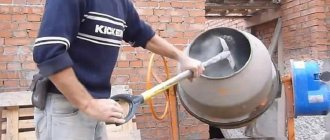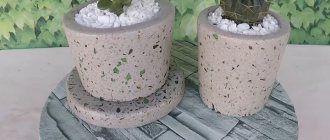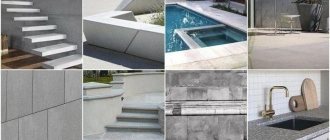Any construction or repair work is impossible without the use of a universal building material - cement of different types and brands. We are so accustomed to this product that we don’t even think about the problem of how cement is made. Is it possible to make it at home and not overpay?
Let’s answer the question right away: is it possible to make cement with your own hands? Having the necessary equipment and raw materials, you can make cement at home. At the moment in the Russian Federation, mini-plants for the production of cement, with a capacity of about 120,000 tons of cement per year, are in great demand. It is not economically profitable to produce cement for a single construction project. It’s easier and cheaper to buy this necessary building material at a factory or store.
What is cement made of?
The material is used very widely. It is used as an independent product and added to solutions. All this is due to the property of the dry mixture - it can become plastic when water is added and after some time harden, turning into a kind of stone. Its characteristics vary somewhat depending on the composition, so it is important to know what cement is made from.
It always contains five main ingredients. Let's look at them using the example of Portland cement, one of the most popular varieties:
- calcium oxide - not less than 61%;
- silicon dioxide - not less than 20%;
- alumina about 4%;
- iron oxide - not less than 2%;
- magnesium oxide - not less than 1%.
Instagram zgbi_kamenskii
Additives are added to the mixture to improve certain characteristics of the material. Different species can be used as raw materials. Production is usually located in close proximity to deposits.
The necessary minerals are mined by open-pit mining, these are:
- Carbonate rocks: dolomite, marl, shell rock, chalk and other limestones.
- Clay rocks: loess, loam, shale.
Apatites, fluorspar, silica, alumina, etc. are used as additives.
- Decoration Materials
What is the difference between plaster and putty: a detailed description for beginners
Large cement enterprises in the world and Russia
The world's largest cement producer is the LafargeHolcim group of companies (France). The main competitors are Cemex (Mexico) and HeidelbergCement (Germany) . The leading representatives of the market are Dyckerhoff (Germany), Italcementi (Italy), Anhui Conch Cement (China), Taiheiyo Cement (Japan), Votorantim Cimentos (Brazil). The leading manufacturers in Russia are the following companies: Eurocement Group, Siberian Cement, Asia Cement, Novoroscement, Sebryakovcement.
Types of material
There are many varieties of cement available for sale. They differ from each other in a number of characteristics:
- Strength. The most important indicator indicated on the label. It is made in the form of the letter M and a number. The latter denotes strength. It is determined as a result of technical tests.
- Fraction. Determined by grinding the mixture. The thinner it is, the higher quality the product is considered. A composition of large and small particles is considered ideal, since only fine grinding requires too much water during mixing.
- Hardening speed. It is varied by introducing gypsum into the mixture. May vary significantly depending on the intended use of the product.
- Frost resistance. Determined by the reaction to the freezing and thawing cycle. A material is characterized by the number of such cycles that it can withstand without changing its properties.
Instagram metallgroupvitebsk
The need for water when mixing a solution depends on the density of the material, so the amount of water for mixing different brands varies. Excess liquid reduces the strength of cement.
Depending on the area of application, there are several types of cement mixtures.
Portland cement
Hardens in air and water. There are no mineral supplements. Widely used for the construction of diverse monolithic structures.
Sulfate resistant
Its feature is increased resistance to chemical aggressive environments. Characterized by a low saturation coefficient. This allows the use of sulfate-resistant cement for the construction of hydraulic engineering, underground structures, etc.
Pozzolanic
Can be considered a type of sulfate-resistant, but with the addition of active minerals. Hardens slowly and is highly water resistant. Used for hydraulic engineering construction.
Aluminous
Increased content of calcium oxide and alumina. This allows the mixture to harden quickly. It is used for the production of quickly hardening heat-resistant and mortars, which are used in repair work, high-speed construction, winter concreting, etc.
Acid resistant
The composition includes quartz sand and sodium fluoride. It is mixed not with water, but with liquid glass. Used to produce acid-resistant coatings. Does not withstand constant exposure to water.
Plasticized
It is made with special additives that impart frost resistance and increased mobility to solutions prepared with this cement. They acquire greater strength, better resistance to corrosion and are characterized by increased water resistance.
Slag cement
Its recipe includes slag, the percentage of which can vary from 20% to 80% by weight of the product. This reduces the cost of the material, slows down the rate of its hardening and increases heat resistance. It is used for the construction of above-ground, underwater and underground objects.
Instagram tsement_82
As practice shows, the most popular option is Portland cement. This is what is meant when talking about cement.
Making at home, what to add for strength and more
In some cases, it is possible to consider the option of self-production . But before you start work, you need to remember that the manufacturing process is very labor-intensive and requires special equipment and skills. In addition, the quality and characteristics of a homemade product are not comparable to the properties of industrially produced cement. Even when using additives that improve properties, in particular plasticizers, this statement will be relevant. Therefore, you should only make the decision to make cement yourself as a last resort.
How cement is made
The manufacturing technology involves the production and subsequent grinding of clinker. This is the name of granules, which are an intermediate product of production. Their composition is always unchanged. This is limestone and clay mixed in a 3:1 ratio. In nature, there is a mineral completely identical in composition to clinker. It's called marl. However, its reserves are limited and cannot meet production needs.
Therefore, factories use an artificial analogue of marl. To obtain it, the necessary ingredients are thoroughly mixed in large containers using special drums. The mass prepared in this way is fed into the oven, where it is fired for about four hours. The process temperature is about 1500°C. Under such conditions, the powder begins to sinter into small granules. After cooling, the clinker grains are sent for grinding. They are crushed in large drums with ball sieves and screens. At this stage, it is important to grind the granules and obtain a powdered product of a certain size. Grinding is determined by the size of the sieve cells. The resulting powder is mixed with the necessary additives, which determine the brand and properties of the product.
Instagram tsement_82
Finished cement materials are delivered to storage or to the packaging area, where they are distributed into containers of various capacities or loaded into special cement trucks.
Despite the general technology, three methods can be used to produce the composition, depending on the properties of the raw materials.
Dry method
This method can significantly reduce the time and costs of producing a cement mixture. It involves several stages:
- The raw material is crushed to obtain fine grains.
- The prepared granules are dried until the desired humidity is achieved. This is done to facilitate subsequent operations.
- The ingredients are mixed in certain proportions. Then it is crushed to obtain flour.
- The powder is fed into a rotary kiln where it is fired, but not sintered into granules.
After cooling, the finished product is sent to a warehouse or packaging area.
The dry method is considered the least energy-consuming, and therefore very beneficial for manufacturers. Unfortunately, it is not applicable to all categories of raw materials.
- Decoration Materials
7 finishing materials that you have not yet used in the interior
Wet method
In some cases, it is necessary to moisten the material prepared for production. In such cases, the wet method is used. To prepare clinker, which consists of limestone and clay, a mixture of the main components is mixed with the addition of water. The result is a viscous mass called sludge.
It is placed in a kiln where firing occurs. In this process, granules are formed from the sludge, which, after cooling, are sent for grinding.
Instagram tabys.cement
The powder obtained from clinker is mixed with ground additives. Only after this the product is ready for packaging and storage. The composition produced using this technology has the highest cost.
- Decoration Materials
Do-it-yourself decorative plaster from putty: mixture recipes and application methods
Combined method
Used to reduce the cost of finished products. It is a kind of symbiosis of dry and wet technology. Initially, sludge is mixed, which is subsequently dewatered. This is how clinker is made. It enters a furnace operating using “dry” technology. Next, if necessary, mixing with fillers is carried out, and the product is ready. The process is shown in more detail in the video.
The quality of cement largely depends on the raw materials from which it is produced and the accuracy of compliance with all technological stages. Considering that the characteristics of building materials made from it are determined by the quality of the mixture, it is worth paying close attention to it.
Making white cement mortar
The production of white cement requires separate consideration. The material is widely used in surface finishing. After drying it becomes white.
The mixture contains marl, limestone, marble, sand and clay, but to a lesser extent compared to gray cement. The majority of the mixture is marble chips. The presence of coloring oxidizing elements is also allowed in the mixture: iron, chromium, manganese, titanium and others. Chalk and kaolin give the solution a whitish tint. There are high requirements for the purity of the water used; its percentage in the total mass is no more than 45%. The material goes through several levels of purification, so the end result is high quality cement. The surface treated with white cement mortar has no flaws.
Clinker grinding continues in the milling unit, in which a specific lining is installed. The delicacy of grinding white cement is much higher than that of ordinary gray cement. Therefore, the mixture is produced in two grades: M400 and M500. Products made from white cement do not crumble, do not collapse, and are easy to care for. Therefore, the material is used to create a variety of architectural structures and forms.
It is important to note that the snow-white color of the material allows you to create other shades. At the final stage of production, a certain percentage of pigment additives is added to the mixture.
To produce each type of cement, special equipment is used, and manufacturers adhere to a certain sequence of actions. Therefore, it is recommended to purchase cement from manufacturers who have already proven themselves in the construction market and provide their products with quality certificates.
Mixing
Wet method of cement production
To create different grades of cement, iron, aluminum dioxide and silicon are added to the prepared rock. The composition and amount of additives is determined after a chemical study of the limestone. The roller evenly mixes the cement components until a homogeneous powder without stones is obtained. Upon completion of the process, the finished mixture is sent for heat treatment.
Main characteristics
What properties of cement should you pay attention to first:
the strength of cement, like concrete, is the most important indicator that determines the choice of raw materials for construction. This parameter is tested based on the maximum load that the cement beam can withstand;
Typically, strength can be determined by the markings of the block. The following designations are usually used: M400 or M500. Binder variations of cement are produced from M300 to M800.
Testing the cement block for strength
activity during steaming is another important characteristic that shows how actively the binder composition tars. The strength of the binder component and the time of heat and moisture treatment directly depend on this indicator. There are 3 steaming groups. The first is the best and most effective;
Steaming samples
These are the two most important characteristics of a binder used in any field of construction. Therefore, with each new batch, even if there is a quality certificate in hand, tests of such properties are carried out. Based on the data obtained, the composition is adjusted.
setting time - the time when the cement composition begins to set. Typically it ranges from 45 minutes to 10 hours. The higher the temperature, the faster setting occurs;
Vicat device for determining setting times
- bulk density - in a loose state it is approximately 900-1100 kg/cm3, in a compacted state - 1400-1700 kg/cm3, this true value is 3000-3100 kg/cm3;
- water requirement - the required amount of water to hydrate the cement and create the plasticity of the dough. As a rule, approximately 17% of the cement mass required for hydration is taken. But it happens that this figure is increased due to the fact that the water demand of the cement itself is higher.
The quality of the astringent property is tested in factory laboratories and, based on such tests, a quality certificate is issued, from which we learn all the characteristics. But we receive it only after a month, since the passport is issued on the basis of testing samples at 28 days of age. Therefore, each new batch is independently tested in the laboratory to find out how high quality it is. The latter depends on the composition of the binder material itself.
Differences between wet and dry production technology
Both cement production technologies have their own nuances, pros and cons. But there are key features that must be taken into account first of all when planning a business and calculating expenses and profits. The main disadvantage of the wet method of cement production is the significant energy intensity of the entire process, which is reflected accordingly in the upward price of the final product.
Dry technology is less environmentally friendly and hazardous to the environment, and therefore requires significant costs to eliminate this factor. At the same time, the production process itself is cheaper in all respects and allows the price of the final product to be reduced.
Equipment selection
If there is not so much money in the budget, then it is better to pay attention to used equipment, since a new one will cost more than 120 million rubles. At the same time, used equipment will cost about 30 million rubles.
Common selections should include raw material processing silos, component mixers, kilns, cone and rotary mills for crushing minerals, conveyor systems, separators, component storage warehouses, and packaging equipment.
The most modern equipment for cement production is considered to be a vertical shaft kiln. They are designed for a volume of 50 to 300 tons of processing per day.
Finding an equipment seller can be difficult. The secondary market is not very rich in such equipment, and new models are supplied by China.
Special Additives
Other components (salts, oxides of calcium, magnesium, phosphorus) are also used in production, but their concentration is insignificant. Additives are added to obtain certain properties - heat resistance, acid resistance, etc. To be able to regulate the setting time of the cement mortar, gypsum is added during production.
The material is manufactured with the mandatory introduction of special additives that increase the performance characteristics of the composition. The production technology involves the use of the following corrective components:
- Additives based on fossil raw materials with a high concentration of alumina.
- Improvers containing silica.
- Ingredients obtained from clay rocks.
- Components obtained from apatites and fluorspar.
The introduction of plasticizers provided for by the specifics of the technological process makes it possible to ensure the following performance characteristics of the composition:
- the ability to resist the penetration of water into the massif;
- reducing the duration of hardening of the composition;
- increased strength of the monolithic mass;
- resistance to long, repeated stages of freezing followed by thawing;
- resistance to the influence of liquid and gaseous aggressive media;
When mixing the solution with your own hands, you must strictly observe the proportions of the components and take care of their quality
- improved adhesion to reinforcement, reliably protected by the concrete mass from the negative effects of corrosion;
- viscosity and mobility of the concrete solution, facilitating masonry and pouring monolithic structures due to the elasticity of the mixture.
Heat treatment
Kiln
The powder is sent to the kiln, in which, under the influence of a temperature of 800 ° C, the process of chemical combination of mineral components in stone flour begins. After the first heat treatment, it is sent to the calciner, where, using a chemical reaction, 95 - 97% of carbon dioxide is removed in a few seconds and the lime is separated. Next, the mixture is sent to a rotating cylindrical oven, in which it is slowly mixed under the influence of a temperature of 1500 - 1800 ° C.
Interesting: How and what is glass made from? Description, photo and video
With prolonged exposure to high temperatures, the powder turns into glassy formations called “clinkers”. Upon exiting the kiln, the clinkers are cooled to 60–80°C, sent to a storage tank and then crushed.
Structure
Cement production is carried out on the basis of the following components:
- clinker, the basis of which is clay and limestone. Clinker determines the strength of the material and is produced by firing clay-containing and limestone raw materials. When heated, it melts, forming a granular composition with a high concentration of silica, crushed, and re-firing;
Cement is produced in factories on an industrial scale
- gypsum, which affects the duration of the hardening process of the cement composition. It is administered, according to the recipe, as stones or ready-made powder, the concentration of which does not exceed 5%;
- modifying additives that expand the range of use of the material by acquiring special performance properties.
Peculiarities
When mixed with water, this popular powder material hardens into a petrified lump. Hardening occurs when there is excessive air humidity or the presence of liquid
The presence of water is an important condition for hardening the finished product.
Depending on the composition, there are several types of cement. Each of them has a degree of hardness unique to it, and the brand and quality of the product are determined by it. Cement, which is made from rocks, is quite reliable. It is made only from quality materials.
Portland cement is the most widely used type of mineral composition, which is also called silicate cement. It hardens in an aquatic environment and in proximity to moist air. The gray-green powdery substance dissolves easily in water when mixed. Once the mixture begins to set, slow hardening begins.
Portland cement is included in the formulation of almost all groups of cement mixtures. The use of this brand in its pure form is a very rare occurrence. Basically, it is part of mixtures, building concrete, and mortars.
Plasticized cement has great advantages over other types. Its use helps reduce costs and time for mixing dry mixtures. The composition is not exposed to low temperatures, excessive humidity, evaporation and other negative influences of the external environment.
Slag cement contains blast furnace slag and crushed clinker. This brand contains additional substances in the form of lime powder and gypsum. Such cement is necessary when combining building mixtures.
Highly active alumina cement has a unique composition. The time before hardening begins is only 45 minutes. It takes about 10 hours for the solution to completely harden. The main advantage of this composition over others is that, regardless of the saturation of the air with moisture, it quickly sets. When this type of cement is added to concrete, new qualitative characteristics appear in it: resistance to dampness, corrosion, and large temperature changes.
The main components of acid-resistant cement composition are sodium silicofluoride and quartz sand. A solution of such a substance cannot be obtained in ordinary water. To prepare a mixture of this powder, liquid glass is used, which is based on sodium. The advantages of acid-resistant cement are that it is very resistant to mineral and organic acids. But with their presence and use, the service life decreases very quickly.
Colored cement contains simple Portland cement to which pigments have been added. This brand is used to decorate buildings and is part of the compositions that are used in the construction of highways based on concrete mixtures. When mixed with water, Portland cement forms a material with a plastic structure. As it dries, it turns into stone.
The advantages of this substance:
- hardening without external effort;
- highly durable and hard substance obtained after hardening;
- increased chemical safety;
- it is an environmentally friendly product;
- fire safety;
- low cost;
- versatility.
White cement is a powder that acquires its light color with specialized production technology and a certain composition. Its recipe contains clinker with a low iron content and contains mineral additives of limestone, chloride compounds, and gypsum. This composition gives the mixture light shades.
Limestone processing
Diagram of a cement production plant
At a cement production plant, rock is unloaded into an apparatus for primary crushing of stones. Large boulders, under the influence of a pressing force of several tons, are gradually crushed to the size of a tennis ball and enter the conveyor. Small and large stones are sent to secondary crushing, where they are reduced to the size of a golf ball and into a fine powder. Limestone, with different percentages of calcium carbonate content, is processed separately.
Diagram of the line for grinding and drying limestone: 1 – belt feeder PL-650; 2 – magnetic separator; 3 – drying complex; 4 – elevator; 5 – supply hopper with a gate head; 6 – belt feeder PL‑500; 7 – mill MTsV-3; 8 – rotary-jet mill MRS-2/770; 9 – cyclone-hopper TsB-4.5; 10 – dust collector II PC-2.0 with hopper; 11 – bag filter FRI-60; 12 – sector feeder PS-1V; 13 – high-pressure fan; 14 – medium pressure fan; 15 – slide valves; 16 – compressor.
This is necessary for their further mixing in different proportions and according to a certain technology in order to produce cement of different grades.











